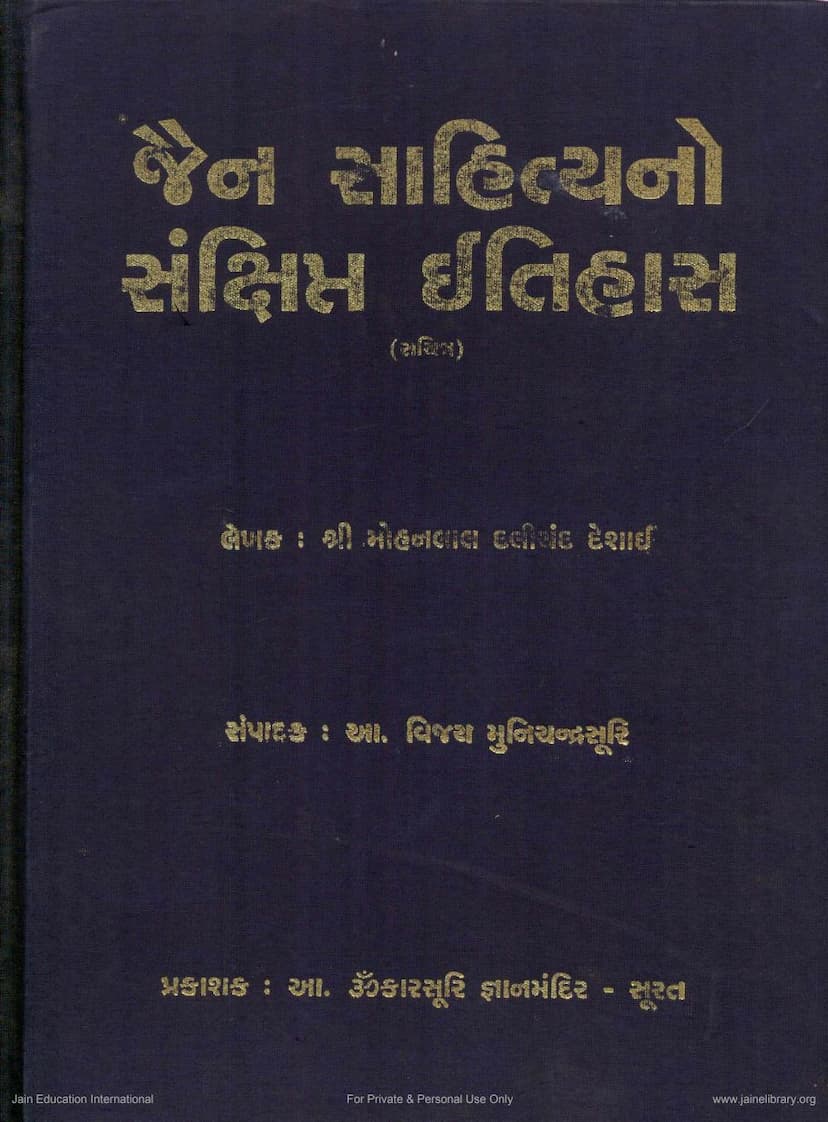Jain Sahityano Sankshipta Itihas
Added to library: September 2, 2025

Summary
This is a comprehensive summary of the Jain text "Jain Sahityano Sankshipta Itihas" by Mohanlal Dalichand Desai, based on the provided pages. The text offers a detailed historical overview of Jain literature, primarily from the Śvetāmbara tradition, from the time of Lord Mahavir Swami up to the year 1960 of the Vikram Samvat (approximately 1903 CE).
Here's a breakdown of the key aspects covered in the text:
Book Details:
- Title: Jain Sahityano Sankshipta Itihas (A Brief History of Jain Literature)
- Author: Mohanlal Dalichand Desai
- Publisher: Omkar Gyanmandir Surat
- Editor (for this edition): Ac. Vijay Munichandrasuri M.S.
- Catalog Link: https://jainqq.org/explore/002175/1
- Scope: Covers Śvetāmbara Jain literature chronologically from the time of Lord Mahavir Swami up to Vikram Samvat 1960 (approximately 1903 CE).
- Emphasis: Primarily focuses on the historical development, key figures, and significant literary works within the Śvetāmbara tradition.
Key Themes and Content:
-
Origin and Purpose: The book originated from a request by Kanhaiyalal Munshi for a history of Jain literature to be published by Sahitya Sansad. It eventually evolved into an independent work. The author, Mohanlal Desai, acknowledges the significant effort and research that went into compiling this history, including extensive study of Jain Bhandars (collections of manuscripts).
-
Chronological Survey: The text presents a chronological journey through Jain literature, meticulously detailing various periods and the authors and works associated with them. The summary mentions specific periods like the Āgama period, the time of Hemachandrasuri, the Vaghela dynasty, the rule of the Solankis, the influence of Muslim rule, and the contributions of prominent figures like Vastupala, Tejapala, and Hemachandrasuri.
-
Key Periods and Figures:
- Lord Mahavir and Āgama Literature: The initial chapters discuss the foundational texts of Jainism, the Twelve Angas and Fourteen Purvas, their original scope, and the gradual preservation and transmission of this knowledge through various councils and Ācharyas like Bhadrabahu, Sthulabhadra, and others. The text notes the linguistic evolution from Ārṣa Prākṛta (Ardhamāgadhī) to later vernaculars.
- Early Historical Figures and Events: The text touches upon the historical context of Jainism, mentioning figures like King Shrenik, Kūṇika (Ajātashatru), King Chandragupta Maurya, and the historical verification of figures like Lord Pārśvanātha. It also briefly discusses the influence of the Maurya period and the rise of different philosophical schools.
- Pāda-liptasuri and the Rise of Sanskrit Literature: The text highlights the significance of Pāda-liptasuri and the shift towards Sanskrit literature, noting the limited information available about some early figures.
- Siddhasena Divākara: This period is emphasized for its contribution to Jain logic and philosophy, with a focus on his rigorous dialectical approach and his monumental work, "Sammati-tarka." The text notes the debates and philosophical exchanges of this era.
- Haribhadrasuri: His prolific output and his efforts to synthesize Jain philosophy with other Indian traditions are highlighted. His broad-minded approach and respect for other viewpoints are noted.
- The Age of Hemachandrasuri: This is presented as a golden era for Jain literature. Hemachandrasuri's multifaceted genius as a grammarian, poet, philosopher, historian, and statesman's advisor is extensively covered. His major works like "Siddha-Haima-Śabdānuśāsanam," "Triṣaṣṭiśalākāpuruṣa-caritra," "Yoga-śāstra," and "Paiśāca Prakāśam" are discussed, emphasizing their scholarly depth and influence. The text also details his extensive patronage of arts and literature, his role in advising Jain ministers like Vastupala and Tejapala, and his interactions with prominent rulers like Siddharaja and Kumārapāla.
- Vastupala-Tejapala: Their immense contribution to Jain architecture, patronage of arts, and their role as influential ministers are detailed, including the construction of magnificent temples like Vimalavasa and Lunavasa at Abu.
- Later Periods: The text continues through the periods of subsequent Ācharyas and their contributions, including the periods of Sthānakavāsī and Digambara literature, and the influence of various dynasties on Jain literary patronage.
-
Scholarly Approach and Methodology:
- Extensive Research: Desai's approach is characterized by its comprehensiveness, drawing from a vast array of Jain manuscripts found in various Bhandars.
- Detailed Indexing: The book includes extensive indices and cross-references, making it a valuable resource for academic study.
- Critical Evaluation: While presenting a broad overview, the text also includes discussions and critiques, such as the differing opinions on the exact time periods of certain Ācharyas or the historical accuracy of some legends.
- Inclusion of Illustrations: The book is noted to be illustrated, with approximately sixty pictures of ancient Jain sculptures, temples, manuscripts, and historical figures, adding a visual dimension to the historical narrative.
-
Literary Styles and Languages: The text traces the evolution of Jain literature through various languages, primarily Prākṛta (especially Ardhamāgadhī for Āgamas) and Sanskrit, but also highlights the emergence and development of Apabhraṃśa and Old Gujarati literature, particularly concerning the works of Jain poets.
-
Contribution to Jainism: The book emphasizes the significant role of Jain Ācharyas and monks in preserving, developing, and disseminating Jain literature and philosophy across various regions of India. It also acknowledges the role of lay patrons (śrāvakas and śrāvikās) in supporting these literary endeavors.
-
Personal Reflections and Challenges: The author reflects on the arduous nature of the task, the challenges of accessing and compiling information from disparate sources, and the importance of continuing such research. The editor's (Ac. Munichandrasuri) contribution in adding new material to make the re-publication more useful is also highlighted.
Overall Significance:
"Jain Sahityano Sankshipta Itihas" is presented as a foundational and indispensable work for understanding the vast and rich history of Jain literature. It is recognized for its detailed scholarship, comprehensive scope, and its contribution to making rare and valuable information accessible to a wider audience. The re-publication, with editorial updates, aims to revive the availability of this crucial text for the benefit of researchers and enthusiasts of Jain literature and history.
This summary covers the main points derived from the provided text, highlighting the book's structure, content, and the author's meticulous approach to the subject matter.